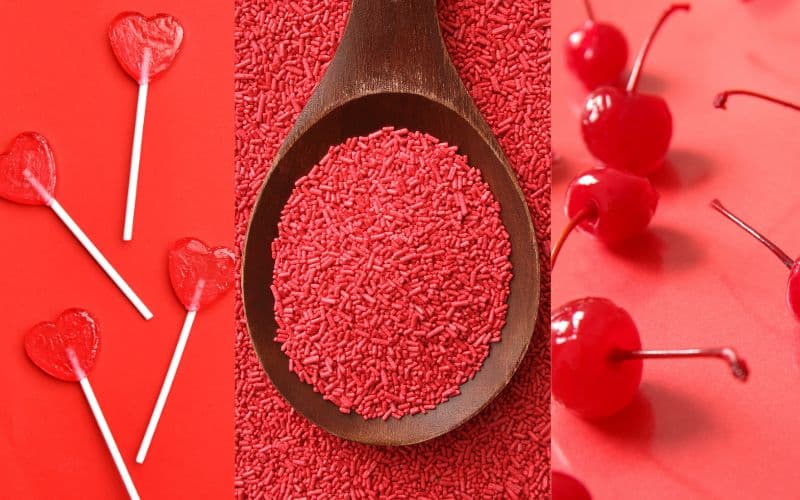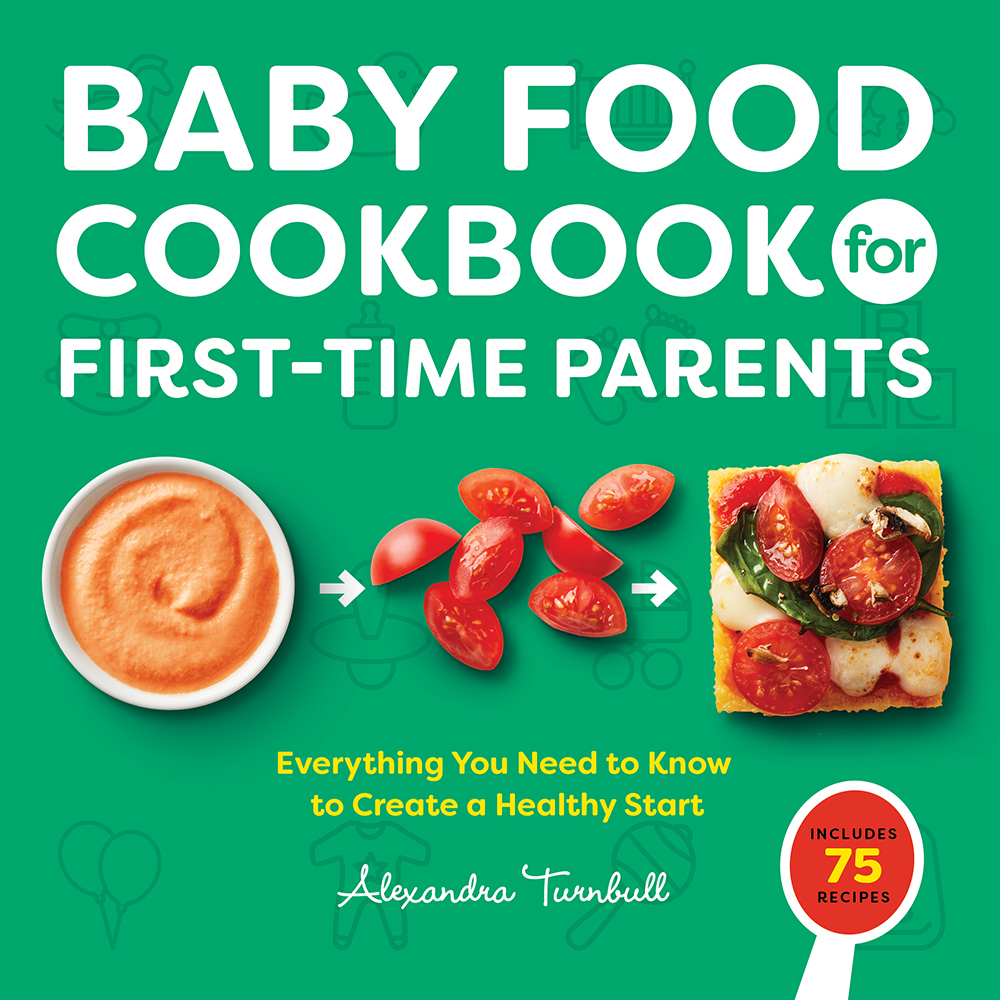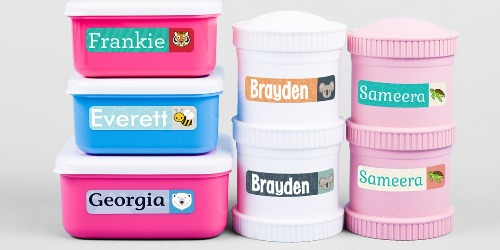
The recent FDA decision to ban Red No. 3 in foods and drinks has brought up a lot of questions—and, let’s be honest, some fear. We’ve seen headlines linking it to cancer, warnings on social media, and debates about food safety in the U.S. But what does the research actually say? Is this ban a big win for public health, or is it more symbolic than impactful?
As a pediatric dietitian and mom, I’m all about giving parents the facts—without the fear. Let’s break it all down, including the science behind the Red No. 3 ban, why it was allowed in food for so long, pros and cons of the ban (because yes, it’s not all butterflies and rainbows), how it compares to other dyes, and where parents can focus their energy for a bigger impact on their child’s health.
Table of Contents
What Exactly is Red No. 3?
Red No. 3, or erythrosine, is a synthetic dye used to give foods a bright red-pink color. It’s made from petroleum—just like many food-safe additives—but that doesn’t automatically make it harmful. In fact, many everyday products are petroleum-derived without causing concern.
Red No. 3 is primarily found in a very small percentage of certain candies and snack foods, though it’s not as common as Red No. 40.
I took a look at my local grocery store and found that some of the common foods that claim to contain Red No. 3, actually didn’t contain it —maraschino cherries and red sprinkles didn’t have it, but red frosting did. Some sources mention it’s in cereals, but I’ve yet to find one that lists Red No. 3 as an ingredient. The key takeaway: just because a food is red doesn’t mean it contains Red No. 3, so it’s always worth checking the label.
Red No. 3 is often lumped together with Red No. 40 under the broader label of “red dye,” even though they’re two different ingredients. Red No. 40 is much more common, found in foods like fruit snacks, cereals, and beverages, while Red No. 3 appears far less frequently. Understanding the difference can help you make more informed decisions and avoid unnecessary worry.
What Does the Research Say About Red No. 3?
Red No. 3 has been a topic of concern since the 1980s when studies showed that extremely high doses caused benign thyroid tumors in male rats. However, these findings have never been confirmed in humans and the FDA states: “The way that FD&C Red No. 3 causes cancer in male rats does not occur in humans.” They also noted that no other studies in animals or humans have been shown to cause the same effects that they did in the male rates.
Here’s what’s important to know:
- The studies that led to concerns used doses far higher than what any child (or adult) would consume through food.
- No research has directly linked Red No. 3 to cancer in humans.
- “Claims that the use of FD&C Red No. 3 in food and in ingested drugs puts people at risk are not supported by the available scientific information.”
- The FDA banned its use in cosmetics and some drugs in 1990 under the Delaney Clause, which prohibits food additives shown to cause cancer in animals from being used in food.
- However, the FDA allowed its continued use in food because they deemed the exposure level too low to be a concern.
So why is it being banned now? The FDA is finally closing this loophole, aligning with past concerns rather than responding to new research.
Why Wasn’t Red No. 3 Banned in Foods Back in the 1990s?
A lot of consumers wonder: If Red No. 3 was banned in cosmetics 30 years ago, why did it remain in food? The answer comes down to risk assessment and industry impact.
- The Delaney Clause applied to cosmetics and drugs but not immediately to food, since the FDA determined that the amount used in food was too small to pose a real risk.
- At the time, banning it in foods would have required reformulating many products, and the FDA prioritized other safety measures instead.
- Now, decades later, with growing consumer awareness and pressure, the FDA is making the ban official.
The ban now is a result of stricter legal standards and growing concerns about food additives, which led them to take precautionary action even without conclusive evidence in humans.
Where Is Red No. 3 Found?
Despite the headlines, Red No. 3 isn’t a major part of the food supply. It’s primarily found in:
- Some types of candies (like certain gummies, jelly beans, and hard candies)
- Maraschino cherries (often used in cocktails and desserts)
- A few frostings and sprinkles
Unlike Red No. 40, which is used in a much wider range of foods, Red No. 3 is in relatively few products and not in every product listed above – it’s very brand-dependent. The amounts consumed, even by kids who eat these foods regularly, are quite small.
Why Not Just Take It Out?
Okay, so if Red No. 3 doesn’t do anything for our health and it’s just there to make our snacks look pretty, why can’t we just take it out? I mean, who even needs it, right? Well, as much as we all love a “cleaner” ingredient list, the reality is that color plays a big role in making food fun. Think about it: kids are way more likely to gobble up a bright pink cupcake than a pale beige one. Red No. 3 might not add any nutritional value, but it adds to the visual appeal – which also has it’s pros and cons.
Now, replacing it with something safer is easier said than done. Natural colorants can be pricier, less stable, or just… tricky to work with on a large scale. But that doesn’t mean we’re not working toward better options.
So, What Can We Use Instead?
- Beet Juice Powder – Yep, beets! Naturally red and can be a bit of a sneaky veggie in your food.
- Paprika Extract – Gives a lovely reddish hue and works well in savory dishes.
- Hibiscus Powder – A bright pinkish-red alternative that makes smoothies, juices, and treats pop.
- Pomegranate Juice – Fancy and a little sweet, it can make things red and delicious.
- Radish Extract – You might not be serving radishes for snack time, but this extract can do the trick in some foods.
While these options may be a more natural option, they also come with a higher price tag and shorter shelf life. It’s all about finding that balance between making food safe, fun, and practical—because as much as we want the best for our kids, we also need to keep it real.
How Do U.S. and International Food Regulations Differ?
There’s a common belief that the U.S. allows many ingredients that other countries ban, but the reality is more complicated and this misinformation is widely shared across all social media platforms.
- The European Union (EU) takes a different approach, often requiring warning labels or limiting certain additives rather than outright banning them. For example, the EU still allows Red No. 3 but with stricter regulations.
- Canada permits Red No. 3 in food but has phased it out of many products over time.
- On the flip side, the U.S. bans some ingredients that other countries allow, such as certain preservatives and food contact substances used in packaging.
Rather than one country being “stricter” than another, it’s more about differences in regulatory philosophy—the U.S. tends to wait for strong evidence of harm before banning an ingredient, while other regions take a more precautionary approach.
I also break this topic down in my post on Red No.40 and hyperactivity in children here.
The Reality of Food Safety
I know some of us might worry about what’s in our food (guilty as charged), but the reality is there are a lot of checks in place to keep things safe. The FDA is all over it, setting regulations, doing research, and reviewing studies to make sure our food is good to go. Ingredients, additives, and even the spices in your pantry don’t just get a free pass—they’re tested and regulated to ensure they’re safe.
Now, I know some folks don’t always trust the process, but it’s nice to know there are multiple layers of oversight working to keep our families safe. So, while it’s totally okay to ask questions and stay informed, just know that food safety isn’t all up to chance—there’s a lot of science and regulation behind it.
Does This Ban Make a Big Impact on Health?
While the Red No. 3 ban can encourage us to take a closer look at ingredients, it’s not likely to make a huge impact on overall health since it’s found in so few foods and hasn’t even been linked to cancer in humans.
It’s always important to continue reviewing research and improving food industry practices, but this particular ban won’t significantly change the health landscape. The bigger wins for health come from focusing on more widespread issues, such as increasing access to nutrient-rich options and encouraging consumers to eat more fruits and vegetables.
When it comes to feeding our kids, the biggest health concerns come from things like excessive sugar intake, lack of fiber, and overly processed diets which are greatly impacted by food insecurity and economic insecurity.
This ban may not significantly improve public health, but it does encourage us to think more critically about what’s in our food and how future improvements can have a larger impact.
The Pros and Cons of the Red No. 3 Ban
Regardless of where you stand on the Red No. 3 ban, looking at the broader impact is important. Even well-intentioned changes can have benefits, limitations, and unintended consequences.
Change is rarely perfect, and it’s important to approach these conversations with balance, recognizing both the positive strides and the complexities they bring.
Pros:
✔ Brings regulations in line with past concerns – The Delaney Clause flagged Red No. 3 as problematic decades ago, so this ban corrects an inconsistency.
✔ Encourages more transparency in food labeling – Removing outdated additives can prompt food manufacturers to rethink ingredients and improve formulations.
✔ Increases consumer awareness – More people are paying attention to food labels and public health, which can lead to better-informed choices.
✔ Responds to public pressure for “cleaner” ingredients – Many parents and health advocates have called for stronger regulations on artificial dyes, and this shows that consumer voices matter.
Cons:
✖ Minimal impact on overall health – Red No. 3 is found in very few foods, so its removal won’t drastically change dietary risks.
✖ Doesn’t address bigger nutrition concerns – Factors like excessive sugar, ultra-processed foods, and lack of nutrient-dense options, and accessibility have a much greater impact on health.
✖ Potential for fear-mongering – While awareness is good, misinformation can lead to unnecessary fear about food safety, causing parents to stress over tiny details rather than focusing on the big picture.
✖ Could lead to unhelpful substitutions – Some reformulated products may replace Red No. 3 with other artificial colors or additives that haven’t been studied as extensively.
While this ban is a step toward more thoughtful food regulation, it’s not the most impactful change for public health. The real win comes when we use this awareness to advocate for bigger shifts in the food system, like increasing access and affordability to nutritious, whole foods.
Where Parents Can Make a Bigger Impact
Let’s be real: while food dyes can be part of the conversation, the bigger impact comes from offering a variety of nutrient-dense foods—fruits, veggies, whole grains, and proteins. But, with rising prices and picky eaters, eating healthy isn’t always a walk in the park. And not every family has easy access to fresh food. So, take the pressure off. Do your best with what you’ve got, and focus on making small, positive changes.
- Prioritize Whole Foods (when you can):
- Offer fruits, veggies, quality proteins, and whole grains most of the time.
- Focus on adding nutrient-dense foods rather than obsessing over removing certain ingredients.
- Balance, Not Fear:
- Instead of banning all foods with dyes, focus on moderation.
- A cupcake with Red No. 3 at a birthday party won’t ruin your child’s health.
- Advocate for Food Policy Changes:
- Consumer demand has led to changes like this ban—so keep pushing for better food quality overall with facts, not fear.
The Bottom Line
The Red No. 3 ban might sound like a big deal, but let’s be real—it’s only in a tiny fraction of foods. While it’s great that we’re all thinking more about what’s in our food, this isn’t something to lose sleep over. What really matters is making sure our kids are getting a balanced, nutrient-packed diet—fruits, veggies, whole grains, and quality proteins—without stressing over every ingredient. So, let’s focus on the bigger picture, nourish our little ones with nutrient-dense food, and remember, no one’s expecting you to be the ingredient police 24/7!





